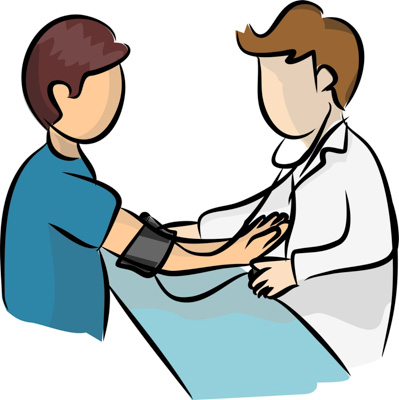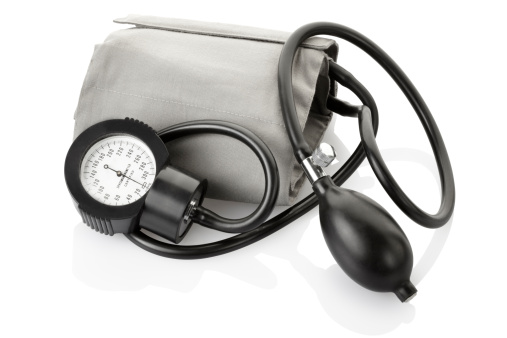Blood Pressure Cuff and Sphygmomanometer

A sphygmomanometer is used to take blood pressure. The sphygmomanometer's cuff has an inflatable rubber bladder that is fastened around the arm. A pressure meter indicates the cuff's pressure. A small, handheld air pump inflates the blood pressure cuff. After the cuff has been inflated, an air valve is used to slowly release air pressure. As the pressure is released, a stethoscope is used to listen to arterial blood flow sounds. These sounds are called Korotkoff Sounds.
The heart's beating pushes blood through the arteries causing a rise and fall of arterial pressure. The highest pressure is called systolic pressure and is followed by a decrease in pressure. This low blood pressure point is called diastolic pressure.
When taking blood pressure, a stethoscope is used to help the user hear blood flow turbulence. The cuff is initially inflated well above expected systolic pressure. At this time, blood flow is stopped. No sounds are heard with the stethoscope. As the value is opened, pressure slowly diminishes. When the cuff's pressure equals the arterial systolic pressure, blood begins to flow past the cuff. This creates blood flow turbulence and can be heard with the stethoscope. When these sounds are initially heard, the practitioner makes a note of the cuff's pressure value. As the cuff's air is continued to be released, the blood turbulence sounds continue to be heard. When the cuff's air pressure falls below the patient's arterial diastolic pressure, the sounds stop. This pressure when the blood flow sounds stop indicates the diastolic pressure.
Blood pressure is measured in units of millimeters of mercury (mmHg). Blood pressure values (readings) should be stated as pairs. The higher (systolic) value first, and then the lower (diastolic) value. For example, "128 over 84". This is written as 128/84mmHg.
Types of Blood Pressure Cuffs

There are mercury, aneroid (mechanical dial), and digital sphygmomanometers. Digital cuffs are automated while mercury and aneroid cuffs are used manually with a stethoscope.
The Patient

The patient's blood pressure can be taken while the patient is supine, seated, standing. In the common seated position, the patient's arm should be at the level of the heart. The arm should be supported and flexed a little. If the subject is anxious, wait a few minutes before taking the pressure.
General Guide to Blood Pressure Readings
- 140/90mmHg or higher indicates possible high blood pressure
- 120/80mmHg to 140/90mmHg indicates pre-high blood pressure
- 90/60mmHg up to 120/80mmHg indicates ideal blood pressure
- 90/60mmHg or lower indicates low blood pressure
Authors and Sources
Authors and Reviewers
-
Heart sounds by Dr. Jonathan Keroes, MD and David Lieberman, Developer, Virtual Cardiac Patient.
- Reviewed by Dr. Barbara Erickson, PhD, RN, CCRN.
-
Last Update: 11/9/2021
Sources
-
Heart Sounds and Murmurs Across the Lifespan (with CD)
Dr Barbara Ann Erickson
Publisher: Mosby
ISBN-10: 0323020453; ISBN-13: 978-0323020459 -
Heart Sounds and Murmurs: A Practical Guide with Audio CD-ROM 3rd Edition
Elsevier-Health Sciences Division
Barbara A. Erickson, PhD, RN, CCRN - How to measure blood pressure using a manual monitor
Mayo Foundation for Medical Education and Research (MFMER) -
Heart and Lung Sounds Reference Guide
PracticalClinicalSkills.com - Manual Blood Pressure Measurement
Vital Sign Measurement Across the Lifespan